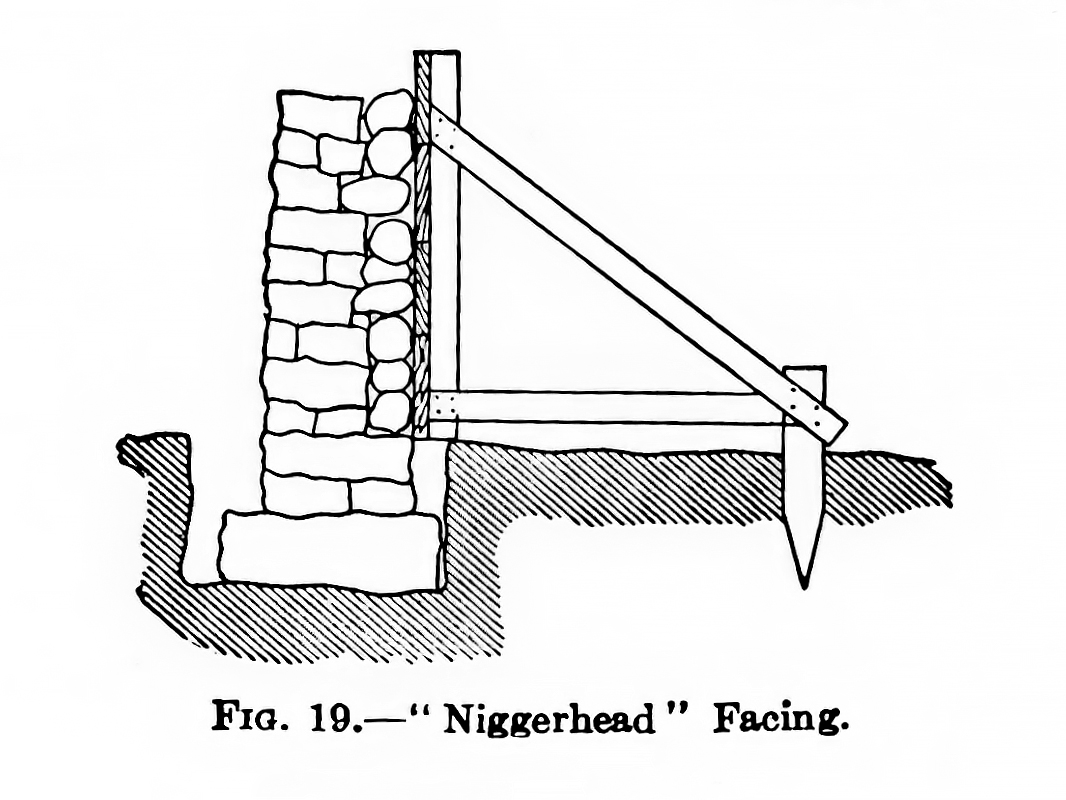Introductory documentation:
"Cobblestone Masonry", by Gerda Peterich. Editor's Note: Illustrations and footnotes were not documented or provided with the original copy of the manuscript in the Cobblestone Museum archives. A later copy of the paper "Cobblestone Masonry" includes a "Notes" section at the end has been found. The illustrations for the paper are provided on a separate page.
"Masonry Details Made of Cobblestone" - Gerda Peterich's 26 pages of handwritten notes on masonry as applied to cobblestone structure construction.
"Cobblestone Masonry", by Carl F. Schmidt.
Editor's Note: Carl F. Schmidt presented the paper, Techniques of Cobblestone Masonry at the Cobblestone Society's first annual meeting, April 29, 1961. This paper and the "Cobblestone Masonry" paper share the majority of content, each prepared for a specific use, which came first is unknown.
"Cobblestone Architecture of the Rochester Area", by Gerda Peterich
"Cobblestone Architecture of Upstate New York", An Account of a Regional Masonry Technique, Text and Photographs by Gerda Peterich. Original manuscript portions of which were presented by Gerda Peterich to the Central New York Chapter of the Society of Architectural Historians at the meeting held on October 15, 1955, at the University of Rochester.
A 9/29/1955 letter from William Henry OLPP (1936-2014) of the University of Ohio at Athens, with information about early European cobblestone structures. Mentions his own dissertation on "The Church Architecture of Roussillon during the Romanesque Period" completed 1957 at NYU.
Excerpts from Gerda Peterich's research notes:
"The Economic Cottage Builder": Cottages for Men of Small Means, by Charles P. Dwyer, Architect and Civil Engineer, Buffalo: Wanzer, Mc Kim & Co., 1856.
Page 35 Chapter III StoneworkRubble - A very neat and economical style of stonework for cottages to rubble face with hammered caps, sills, and base. But the inside of the walls must be furred, lathed and plastered; otherwise, the house will always be liable to dampness.
Cobble - What is called cobblestone work looks very well in cottages. The walls are built of the roughed and most irregular stones, and the outside thickly coated with strong mortar, into which are hammered wet cobble-stones, forming regular horizontal courses of similar sized stones, the intermediate space being thick with small pebbles in as great variety of hues as can be obtained. But the quoins of this style of building should be regularly built up and bonded into the wall. They may be bush-hammered or hammer-dressed.
In finishing off a cottage such as this, it would add greatly to its uniqueness to pave a platform around it in the same style. Transcribed from Gerda Peterich's handwritten notes, later edited when compared to the original book from the Cobblestone Museum "Resource Center".
Editor's Note: Following is a note likely written by Olaf William (Bill) Shelgren (based on handwriting) about the text on page 35."This [book] had no influence on cobblestone buildings I am quite certain. The reference to intermediate spaces being stuck with small pebbles sounds like it came from some English book. "Pargetted joints" is the English term and they don't appear in New York State cobblestones."
The influence the book had is likely little to none, since after the 1855 date of the first edition, relatively few cobblestone structures were built. The usage of the term "Pargeted joints" (correct spelling) is typically a plastering technique of applying a protective mortar layer from weather or a decorative device to create three dimensional designs. Is Bill referring to a more basic use of plastering including small pebbles to cover the exterior face of the rubble wall to provide a reasonably flat vertical surface to which the cobblestone veneer is then applied? Also saying the the "Pargeted joints" don't appear in New York State cobblestones is unfounded. Over 900 cobblestone structures are documented in New York State. Very few structures in comparison have had had enough cobblestone veneer removed to determine whether or not the plastering technique was ever used. Cobblestone masons were particularly secretive about their work, so little is known.
"The Building Mechanics' Ready Reference", Stone and Brickmasons' Edition, H. G. Richey, John Wiley and Sons N. Y., 1907.
Part 1, Stone Masonry, page 7Cobblestone or "Niggerhead" (No. 2 definition) Facing - Retaining - walls, fences, and in some cases walls for dwelling-houses are built faced with cobblestones, or "niggerheads", as they are sometimes called. To keep these stones straight and in line until the mortar hardens is a very difficult piece of work for the mason. A quick and easy method is to build a form of plank for the face of the wall as shown by fig. 19, and build the cobblestones up against this form. This will make a straight and even wall, such as can be obtained in no other way. After the mortar has hardened the form can be taken down and the joints between the cobblestones cleaned out sand pointed.
Our book suggests that wet sand is put between in front of each stone as it is laid, between the stone and plank to keep stone clean. Sand will fall off with board. Comment in Gerda Peterich's handwritten notes, not included in the book.
"Masonry Longman's Technical Handicraft Series", George R. Barham, Published by Longmans, Green And Co, London, 1914
Page 63 "damp-proof course"Page 66 "Rubble walls, unless coursed, must therefore be built one-third thicker that walls of brick or regular coursed stone."
"Flint is used in districts where chalk abounds for building walls. The flints are found embedded in the shack, and large quantities are found under the chalk. Large pieces are sometimes split, chipped square and built in regular courses. Or smaller flints are split, the split surface forming the face, or thirdly, the flint pebble is used in one piece. Borders or lacing courses of larger stones or tiles should be used to give longitudinal and transverse strength, and the angle at the end of the walls, doors, windows, etc., should be built in wrought stone on brickwork."
"New York's Cobblestone Landmarks", by Robert W. Frasch with photographs by Chester A. Peters of Pultneyville, NY. Editor's Note: Earlier shorter version, "New York's Unique Cobblestone Architecture", by Robert W. Frasch, reprint York State Tradition, Saranac, New York, Spring 1965
Sources of Cobblestones | ||||
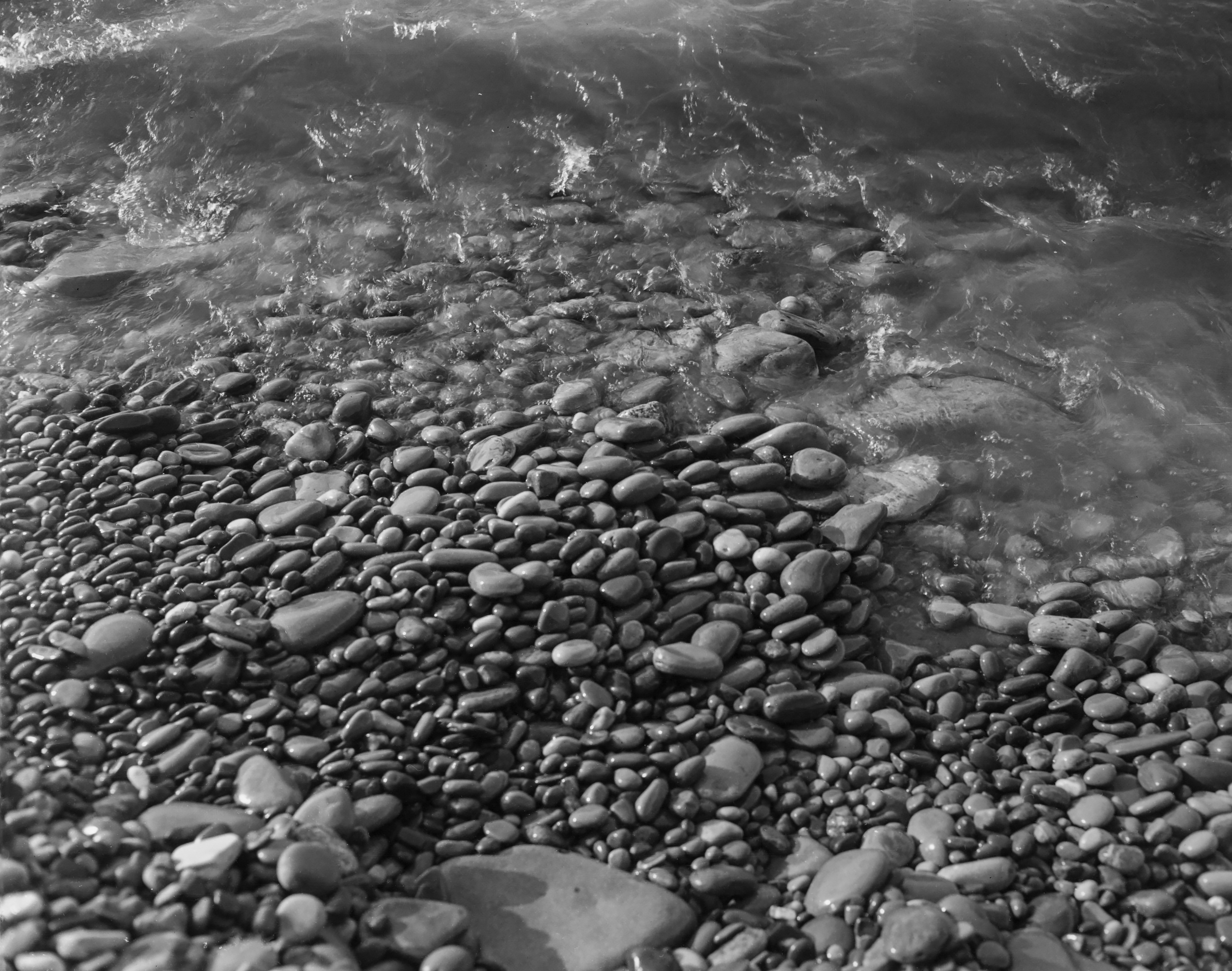 GP Misc Cobblestone Wall 1-1 P.jpg ¹ Action of the waves rounding and smoothing cobblestones. | 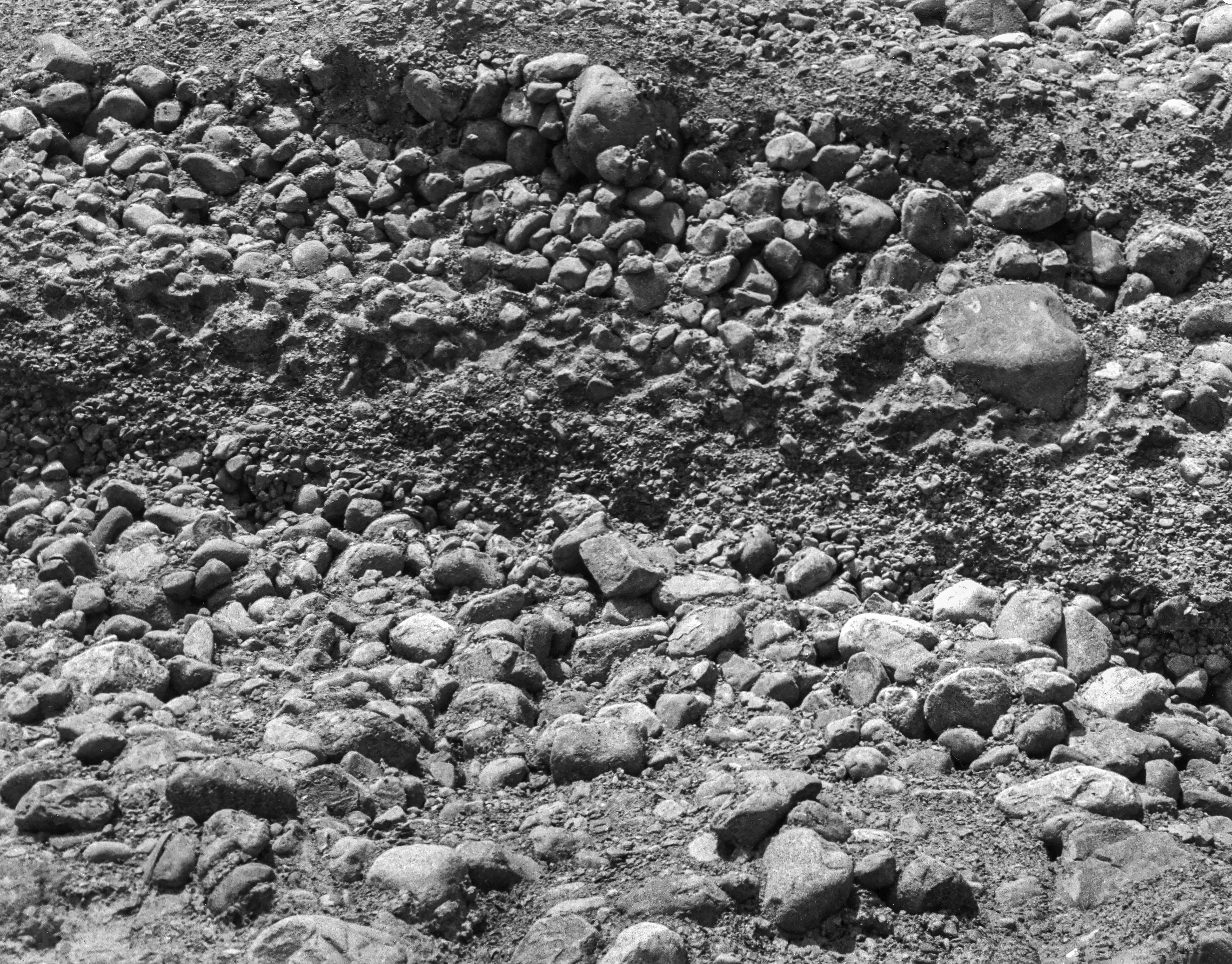 GP Misc Cobblestone Wall 2-1 P.jpg ¹ A field might have visible on the surface or unearthed cobblestones. | |||
| Additional photographs of lake stones and stone locations in "New York's Cobblestone Landmarks", by Robert W. Frasch with photographs by Chester A. Peters of Pultneyville, NY. | ||||
Cobblestone ConstructionThe best way to understand how a cobblestone wall was constructed is to examine damaged or ruined structures. | |||
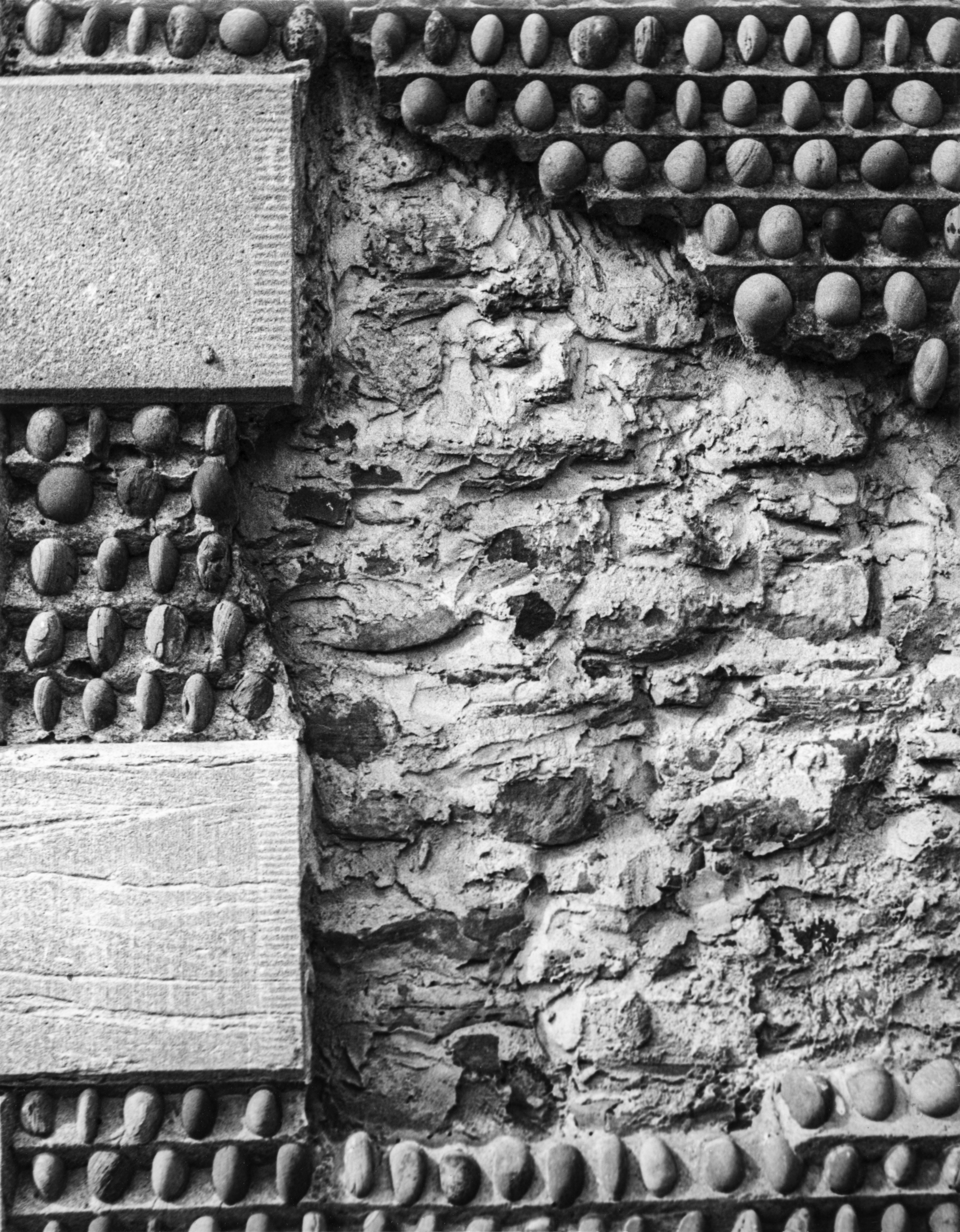 GP Misc Cobblestone Wall 3-1 P.jpg ¹ The rubble wall behind with the cobblestone veneer consistently and orderly constructed over the wall. Preparation to replace the water washed cobblestones in a damaged portion of a side wall in the Robert Spence House. | 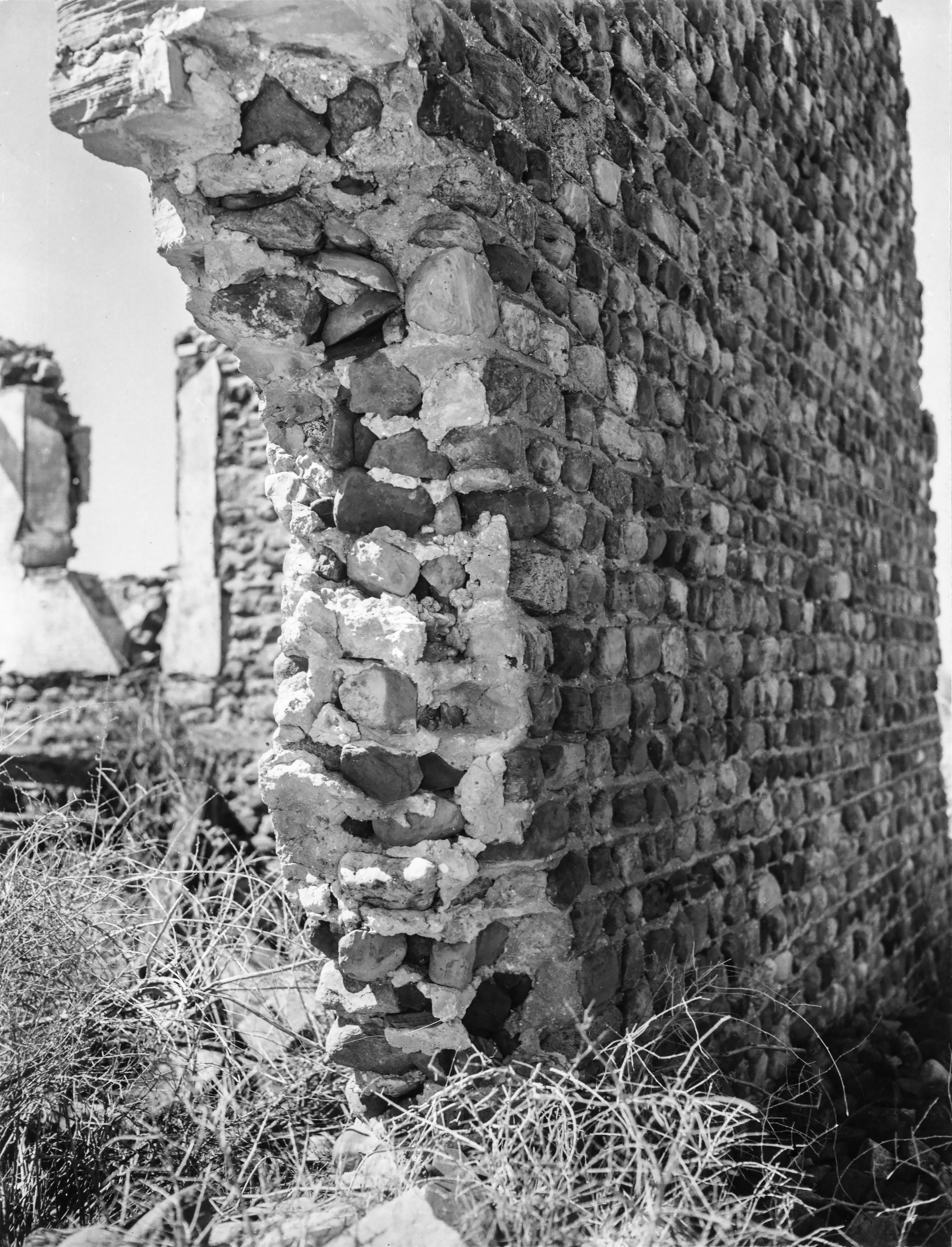 GP Misc Cobblestone Wall 4-1 P.jpg ¹ Cross section of a ruins wall. About 2/3rds of the left side is the rubble wall covered with a veneer of more irregularly shaped field stone. | 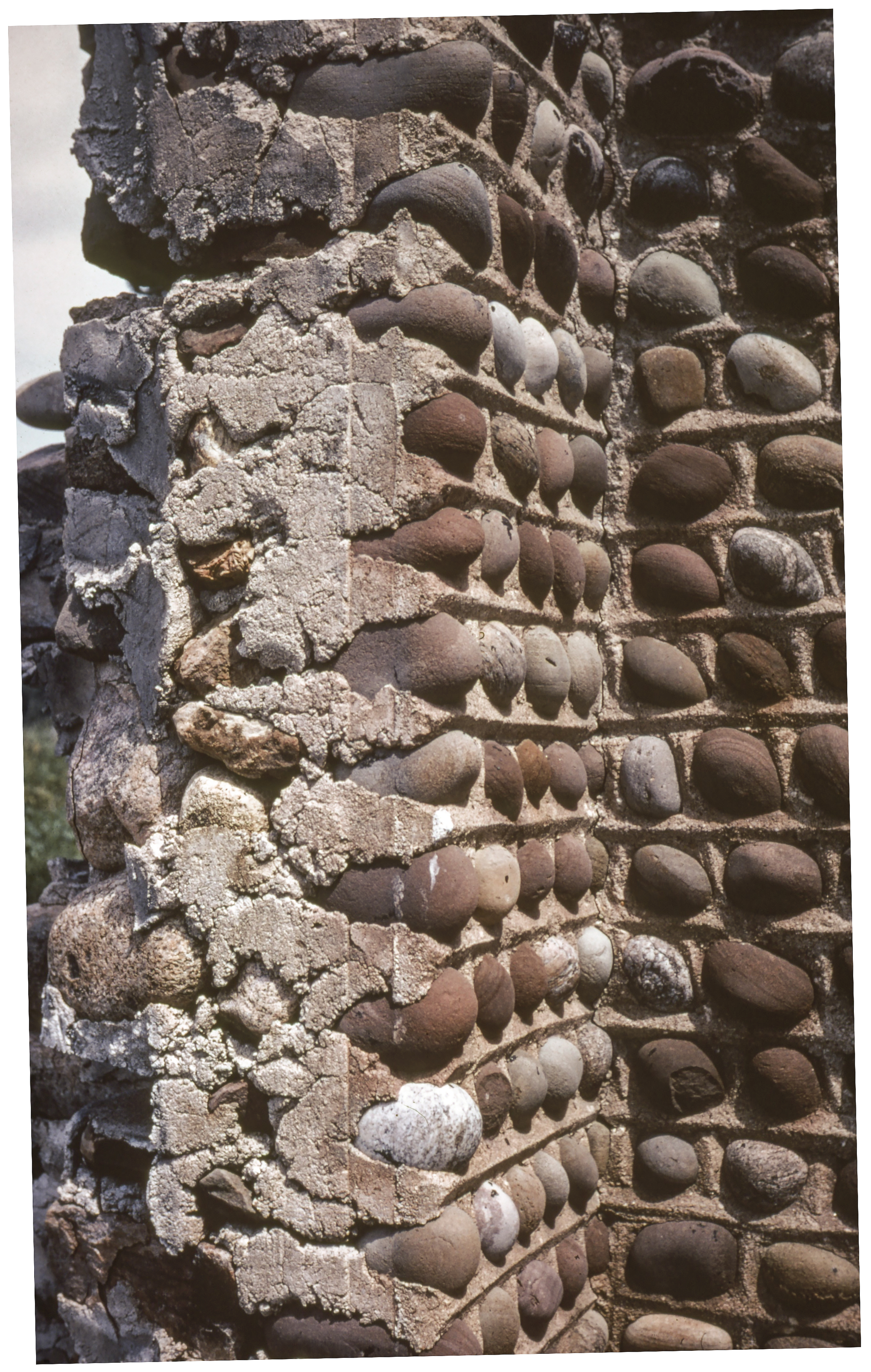 Jun-13 Thorn House Ruins 3.jpg ² Photograph by Robert W. Frasch Jun-13 Thorn House Ruins | 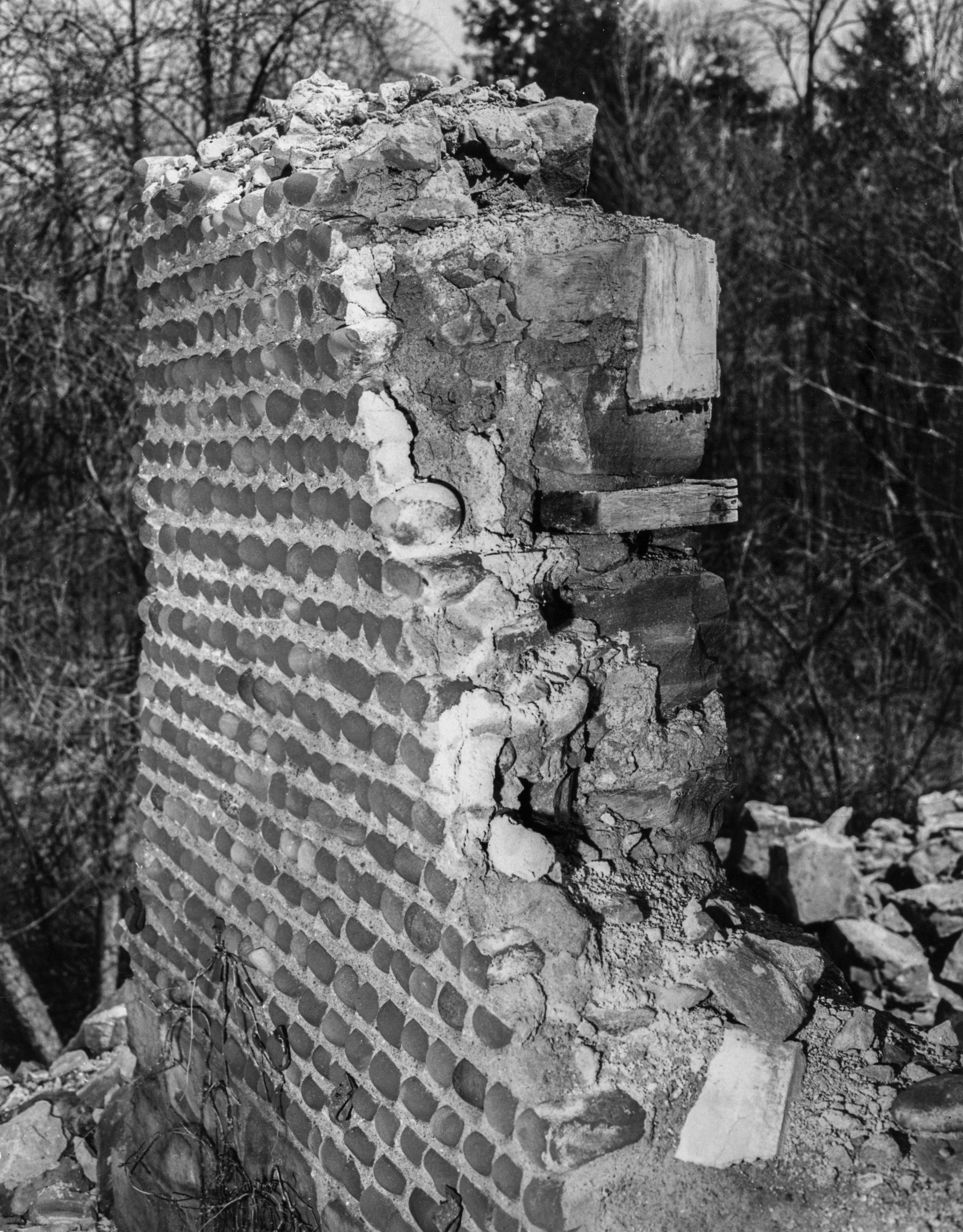 GP Wayne Walworth Wal-14 1-1 P.jpg ² Wal-14 Unknown Ruins. |
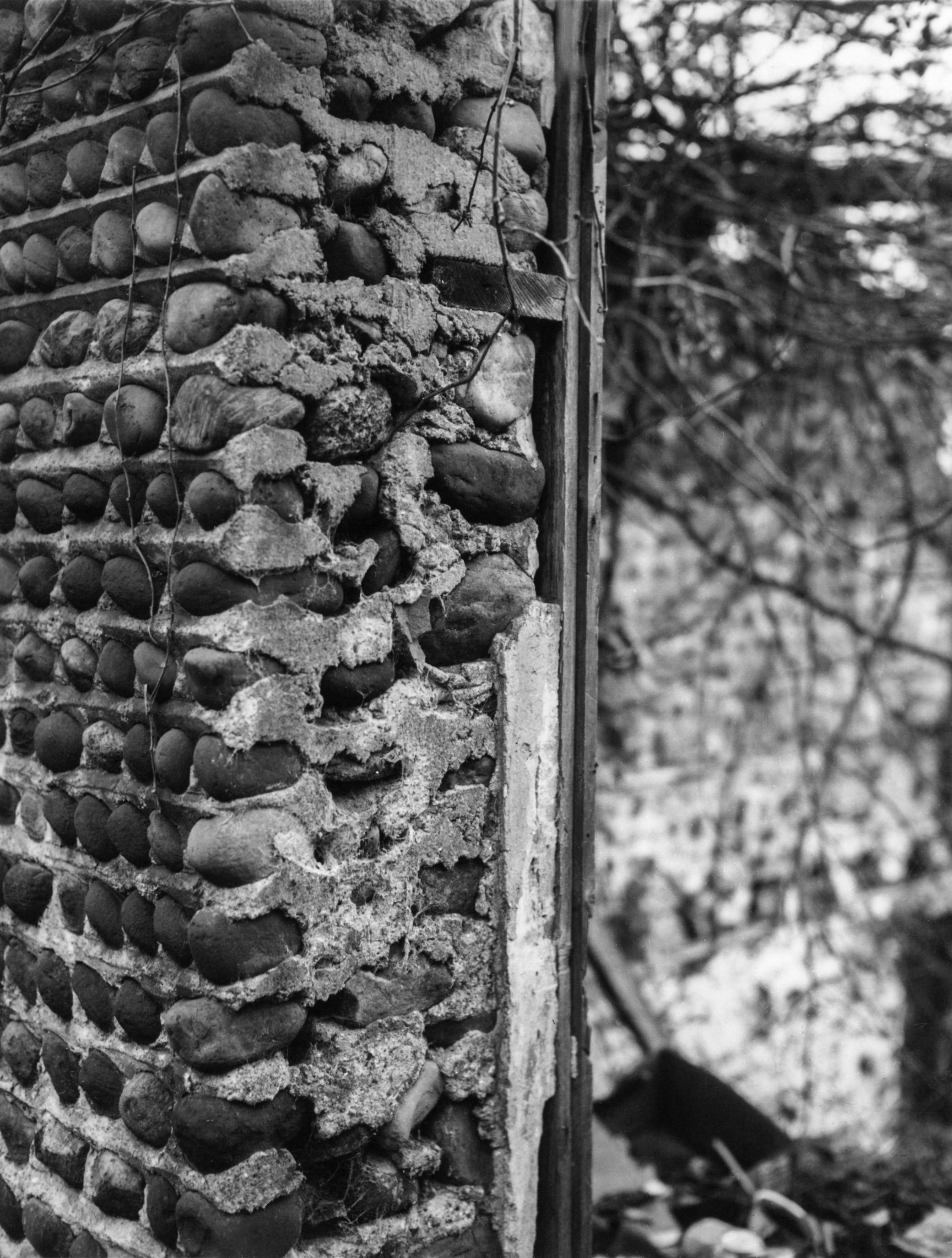 GP Misc Cobblestone Wall 5-1 P.jpg ¹ | |||
Laying of CobblestonesDetailed architectural drawings of stone type and arrangement, and fashioning of mortar are provided on pages Pages 229 through 265 in the book "Cobblestone Masonry", 1966, by Carl Schmidt.The overall appearance of an authentic cobblestone structures walls depended on how the cobblestones were selected, how consistently they were oriented and laid in the mortar in an organized fashion in straight rows, and how the visible mortar was fashioned. Less desirable and/or less attractive stones were frequently used on walls less visible to the public; however, the stones were typically consistent on each wall. Any or all of the walls could have different stones and stone arrangement. The finest construction had very similar walls throughout with carefully selected and arranged cobblestones.
The definition of cobblestone is "a naturally rounded stone larger than a pebble and smaller than a boulder; especially, such a stone used in paving a street or in construction". Courtesy Mirriam-Webster Dictionary. Applied to cobblestone structure construction, the term "cobblestone" is rather loosely used and quite generic. Since both water-washed and field stone are both significant in cobblestone structure construction, the type of stone is less important than consistent selection of size, shape, color, and texture of each stone, and the orientation and placement of the stone in the mortar in orderly and straight rows of more or less the same height. Fashioning the visible mortar into geometric patterns is a typical characteristic of cobblestone construction, but is more decorative than a necessity, and may not be done in some cases. Essentially the cobblestone veneer on a rubble walled structure is a protective layer against the elements and harms in the environment, done in an esthetic manner. | |||
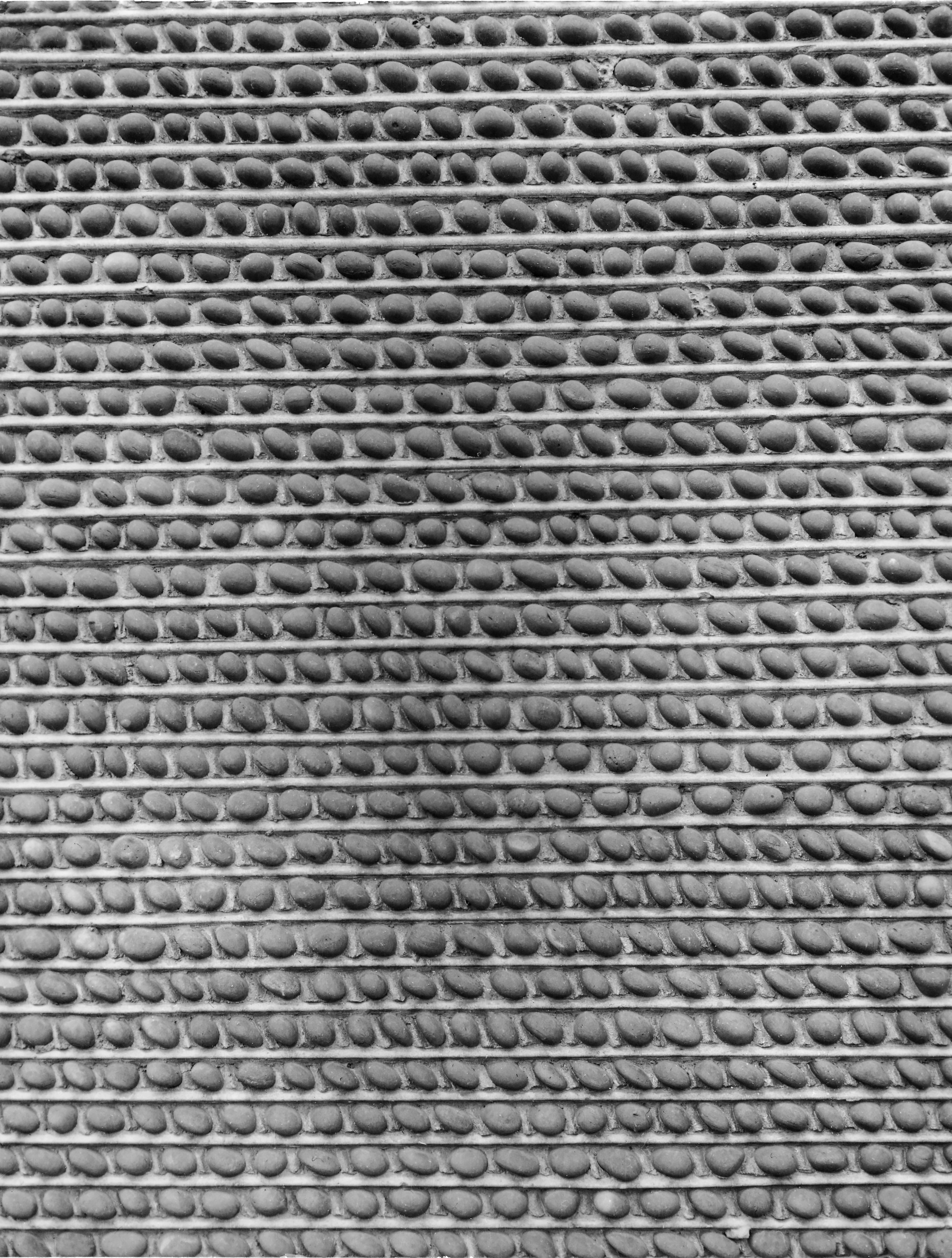 GP Misc Cobblestone Wall 6-1 P.jpg ¹ Cobblestones gathered at a Lake Ontario Beach. Straight rows of lake-washed cobblestones, most likely laid with the help of a board. Attention paid to all details. | 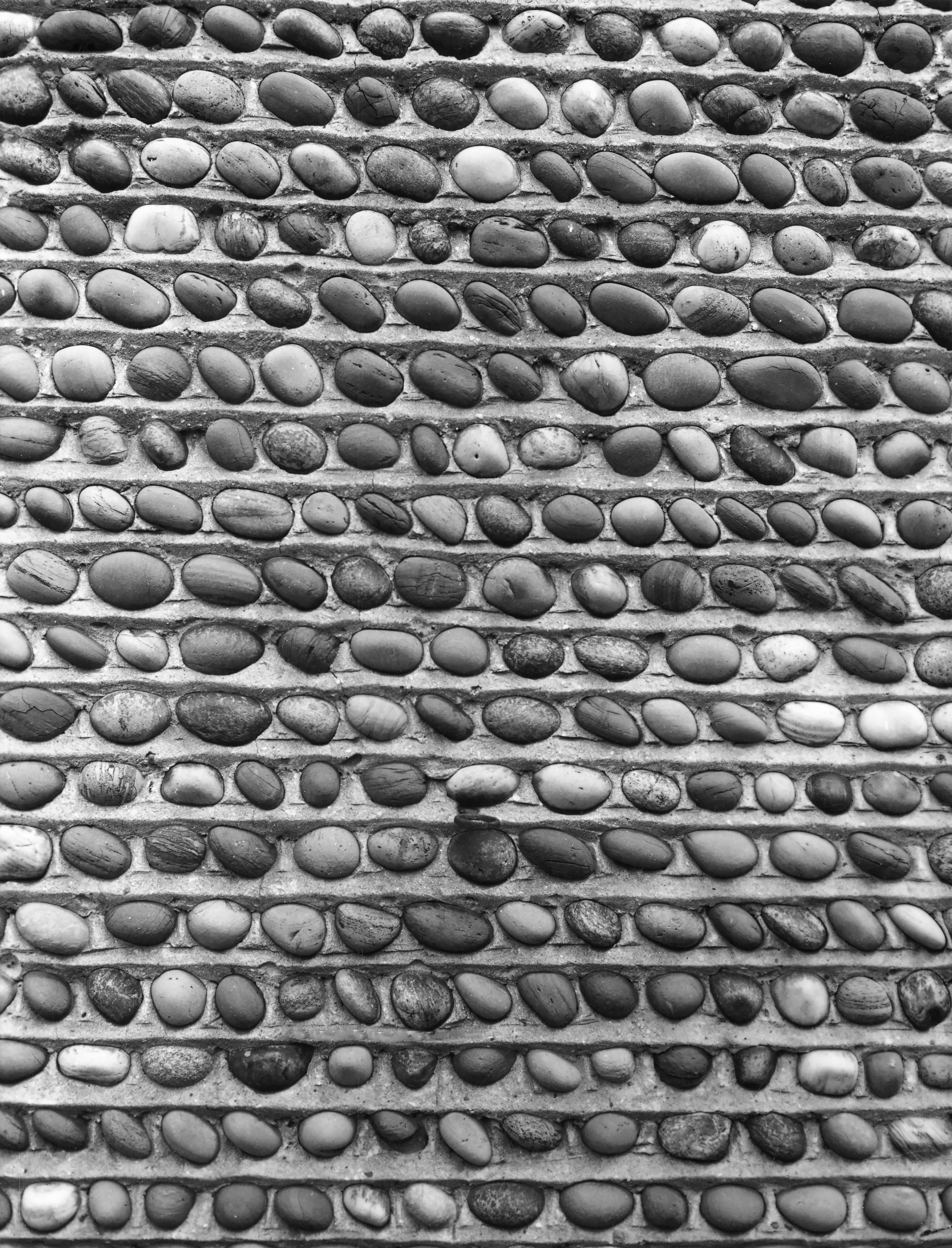 GP Misc Cobblestone Wall 7-1 P.jpg ¹ Straight rows of lake-washed cobblestones; however, less similarity between the cobblestones, and some variability in all aspects, thus less organized overall. Many stones angled to the left. | 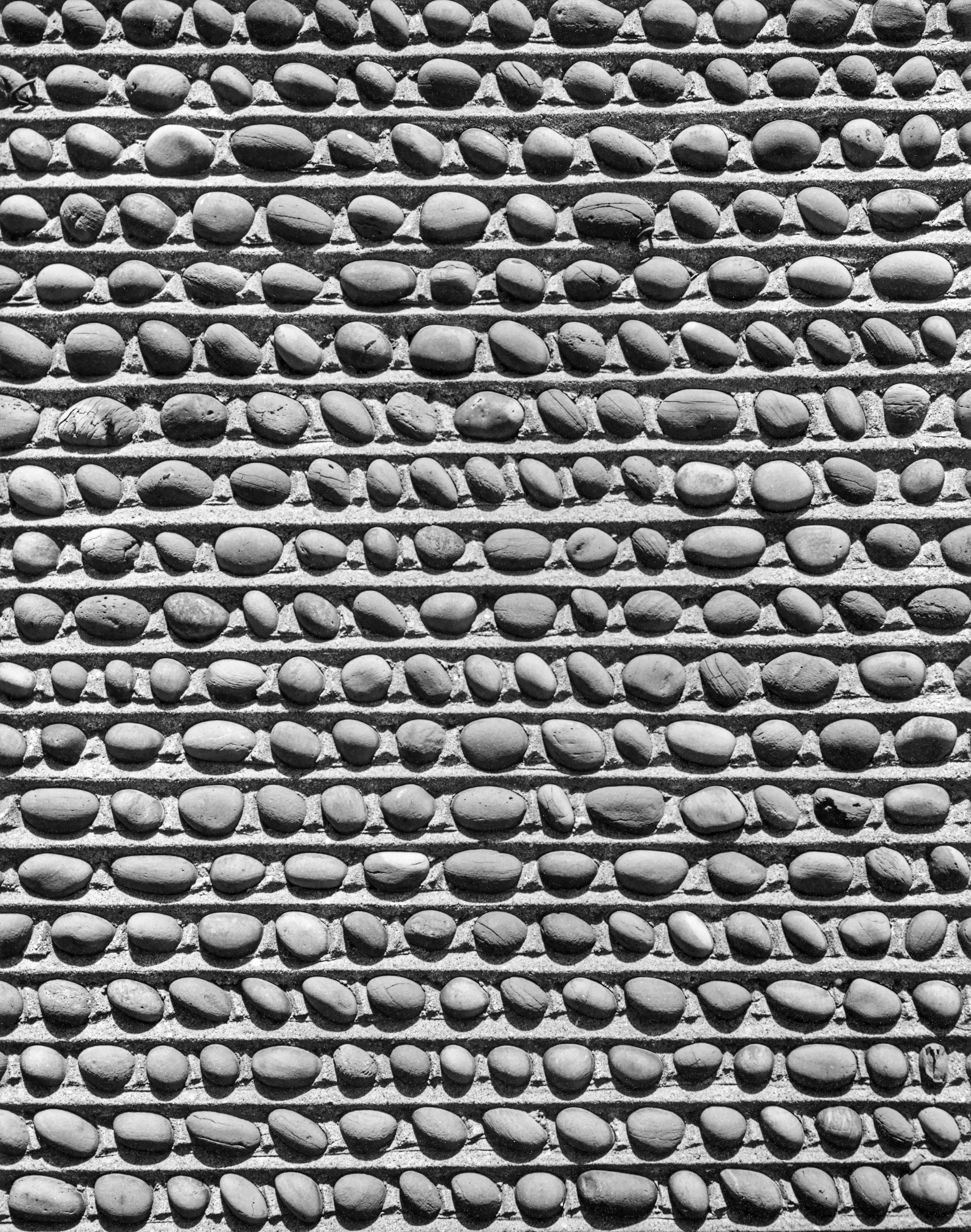 GP Misc Cobblestone Veneer 4-1 P.jpg ¹ Many stones angled to the left. Horizontal "V", vertical pyramids mortar pattern. | 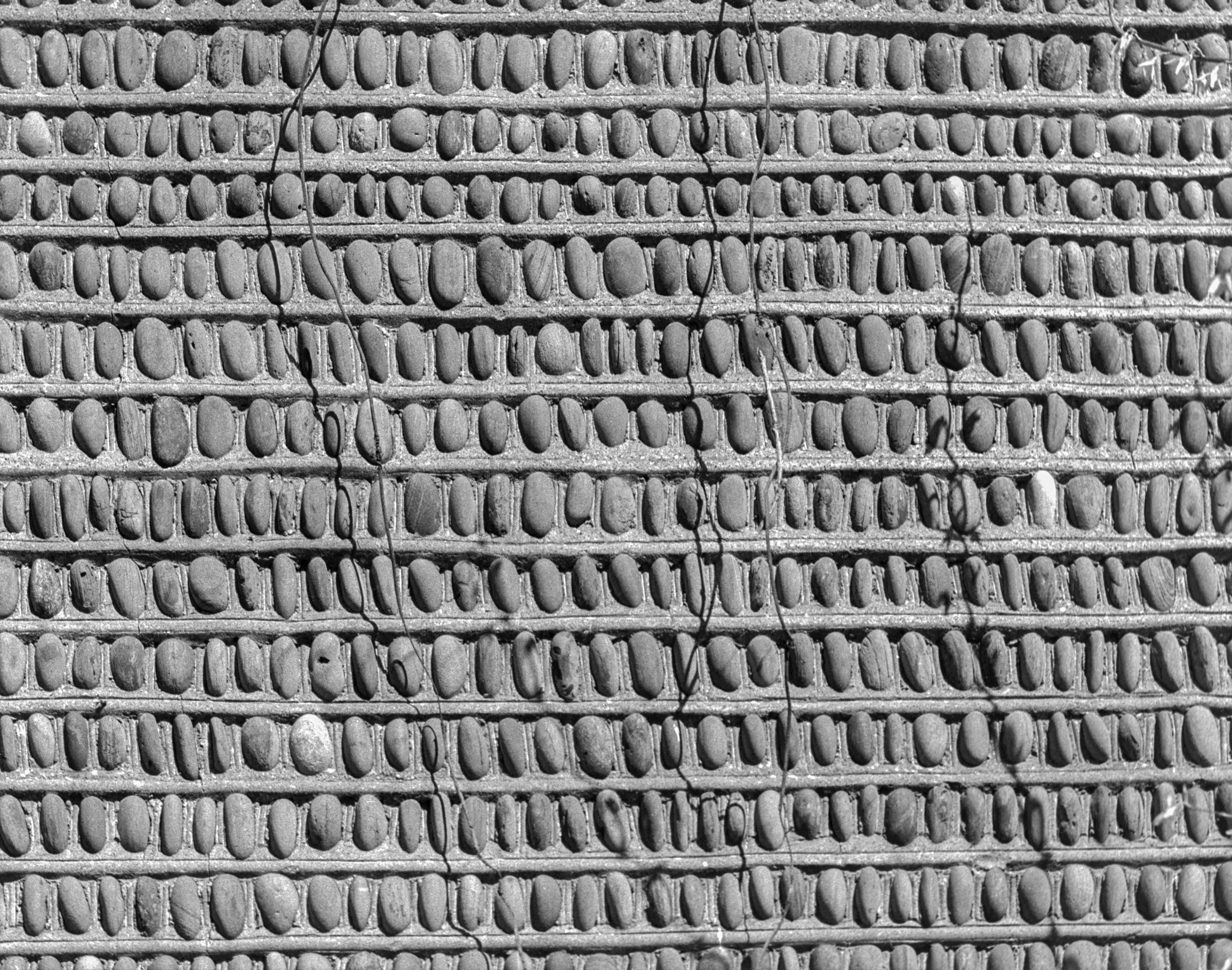 GP Misc Cobblestone Veneer 6-1 P.jpg ¹ Vertical stone pattern. |
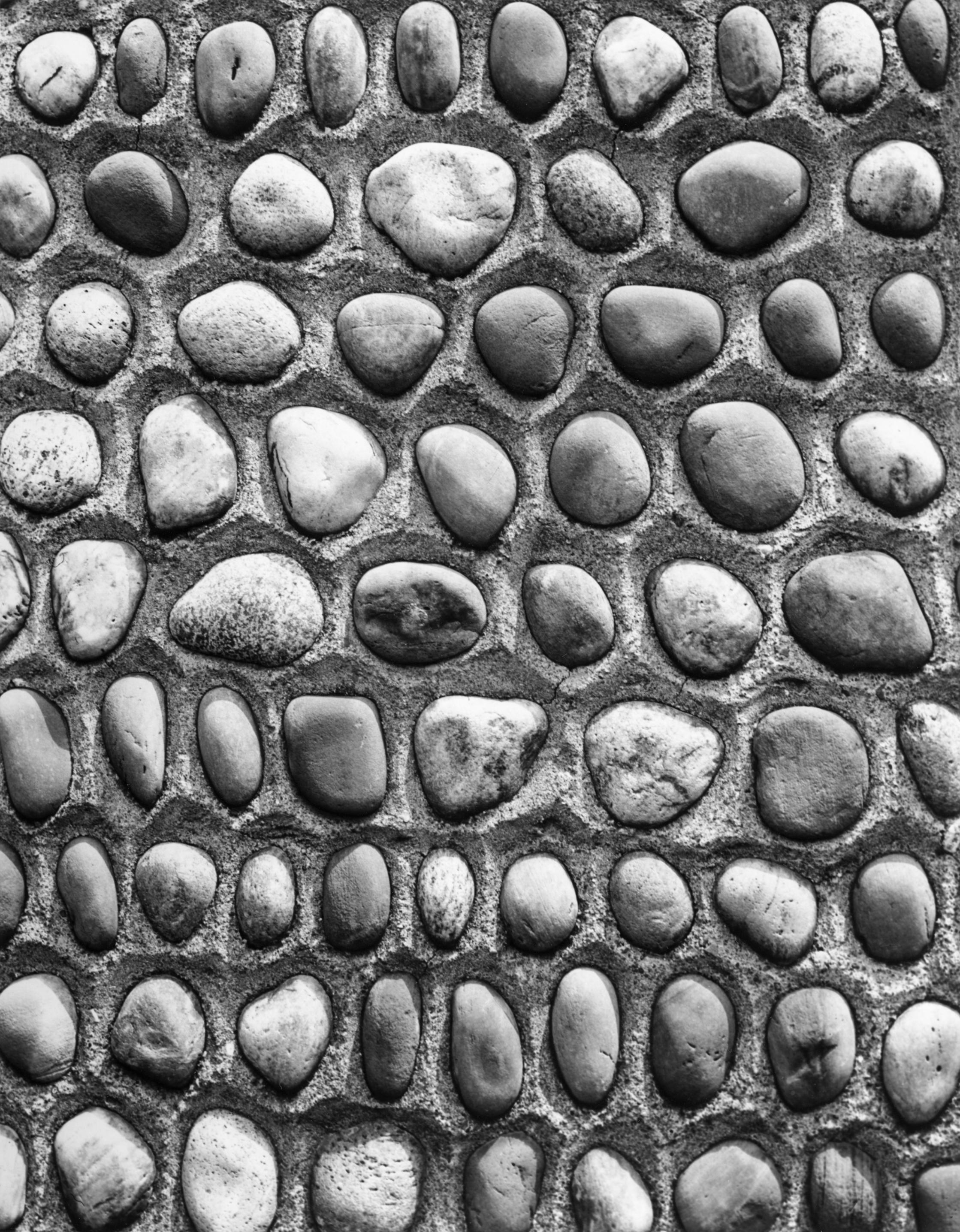 GP Misc Cobblestone Veneer 7-1 P.jpg ¹ Hexagonal mortar pattern. | 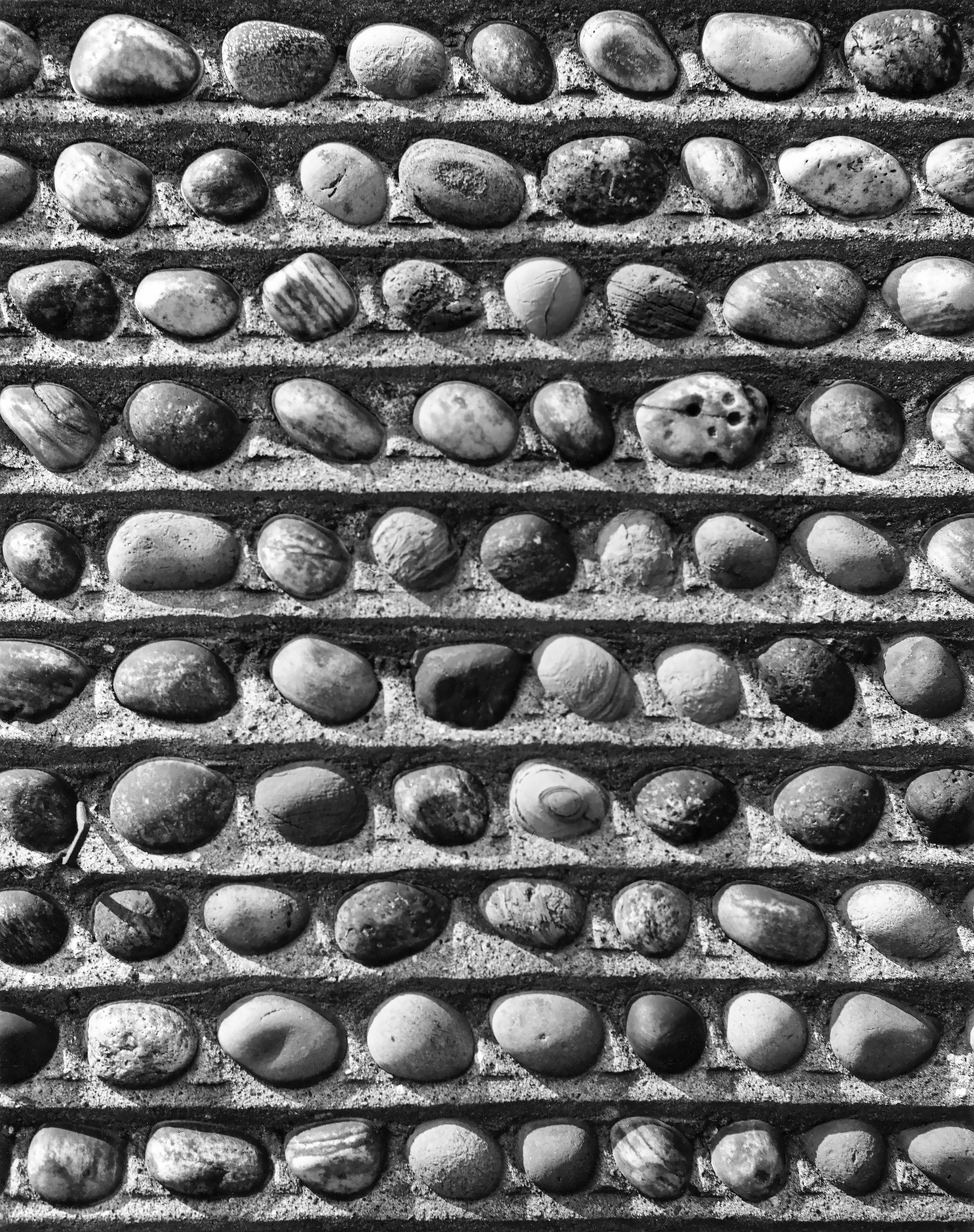 GP Misc Cobblestone Veneer 1-1 P.jpg ¹ Heavier mortar application in relation to stones. | 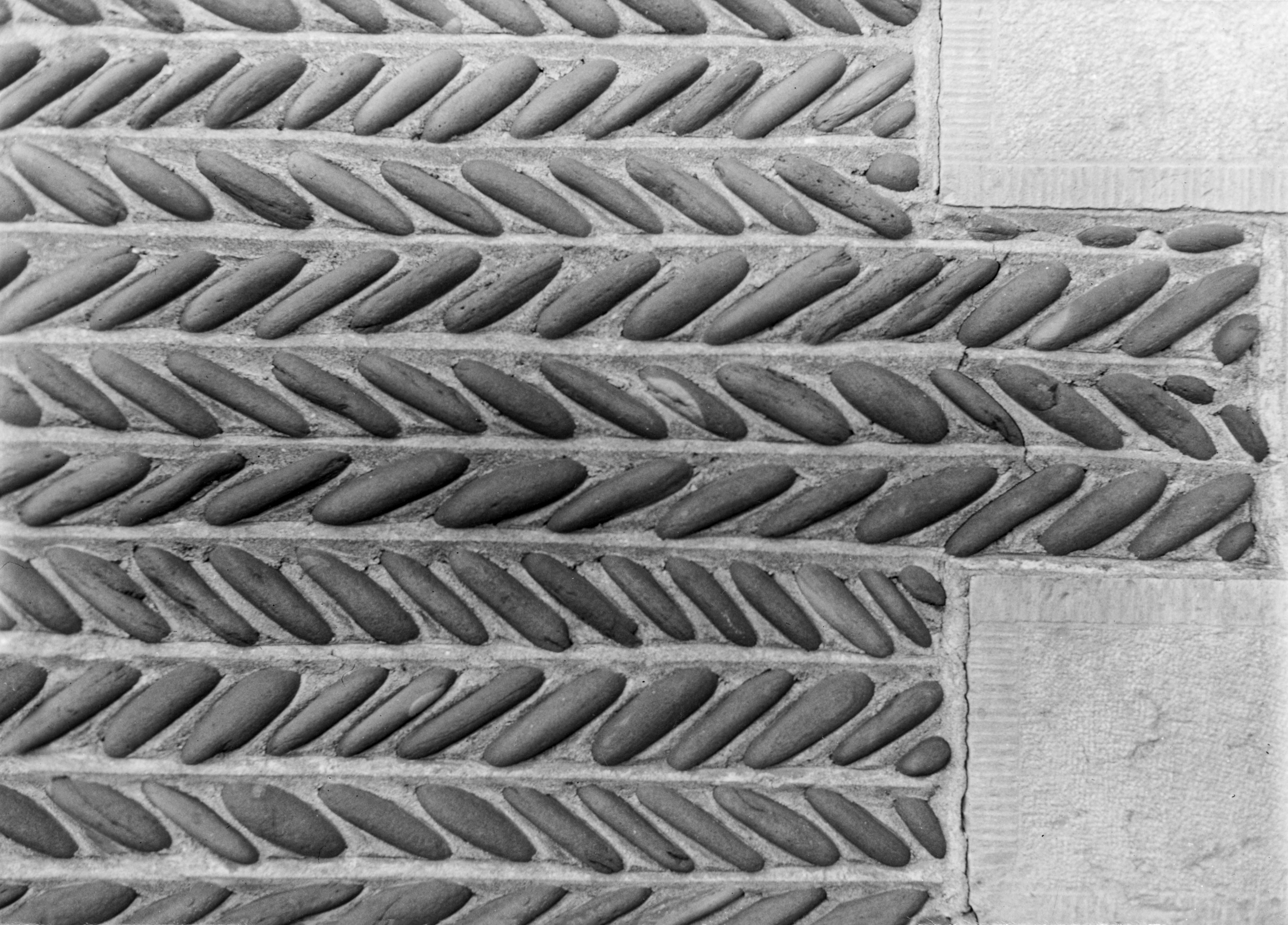 GP Wayne Macedon Mac-6 4-1 P.jpg ¹ Mac-6 Ernest. Carefully laid herringbone stone pattern. | 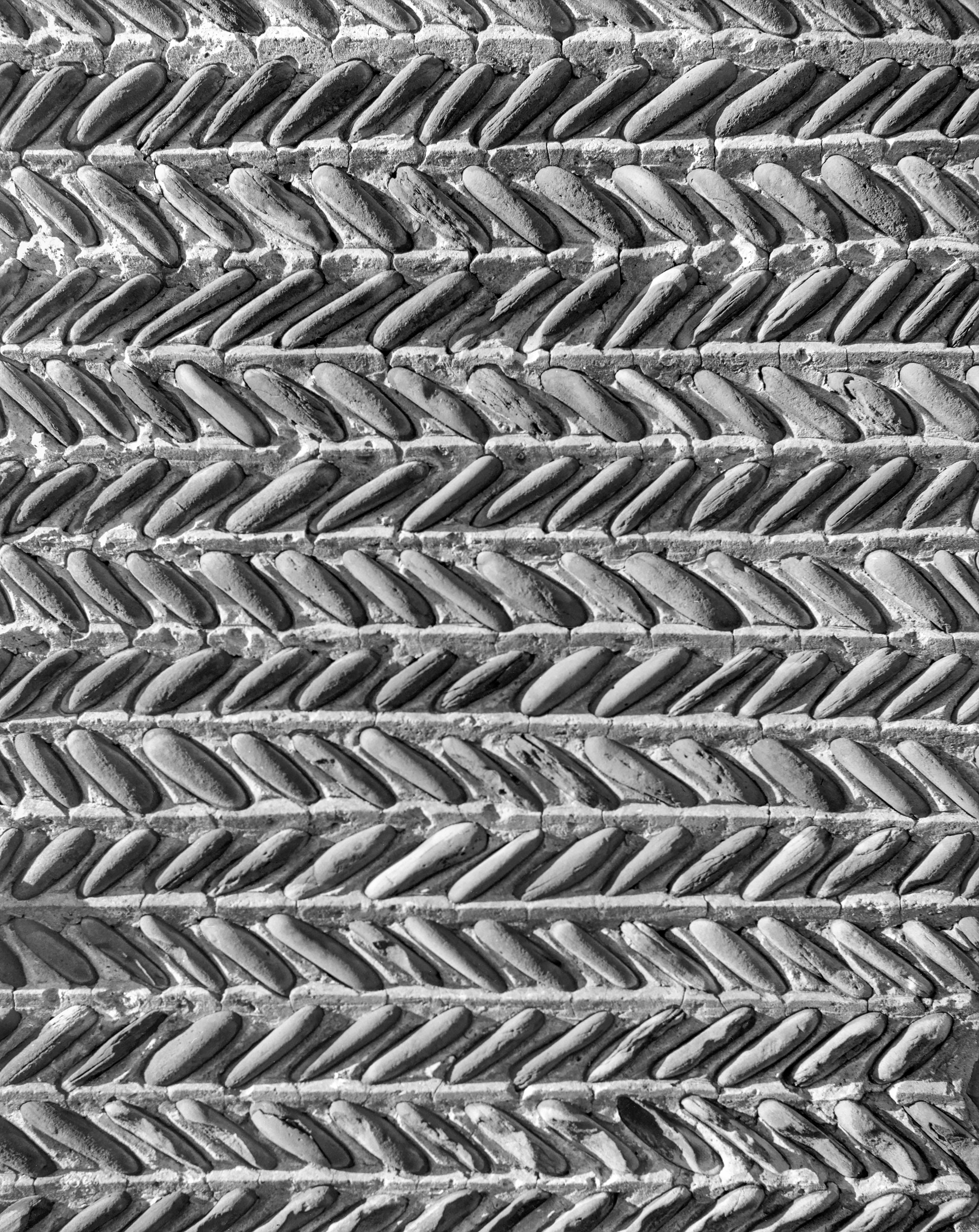 GP Misc Cobblestone Veneer 2-1 P.jpg ¹ Unidentified - Carefully laid herringbone stone pattern. |
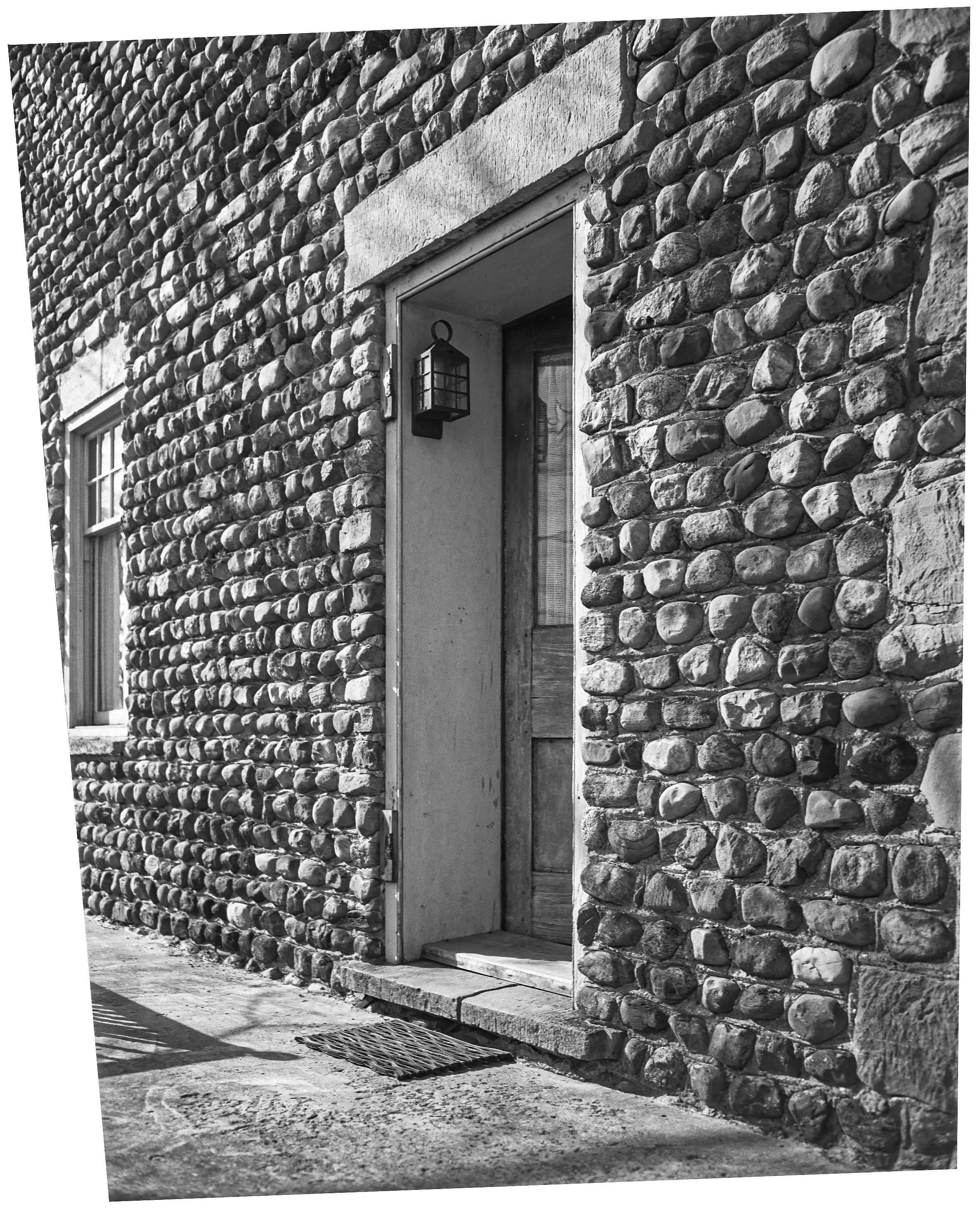 GP Ontario Farmington Far-1 2-1 N.jpg ¹ Coursed rubble wall. Far-1 Herendeen House. | 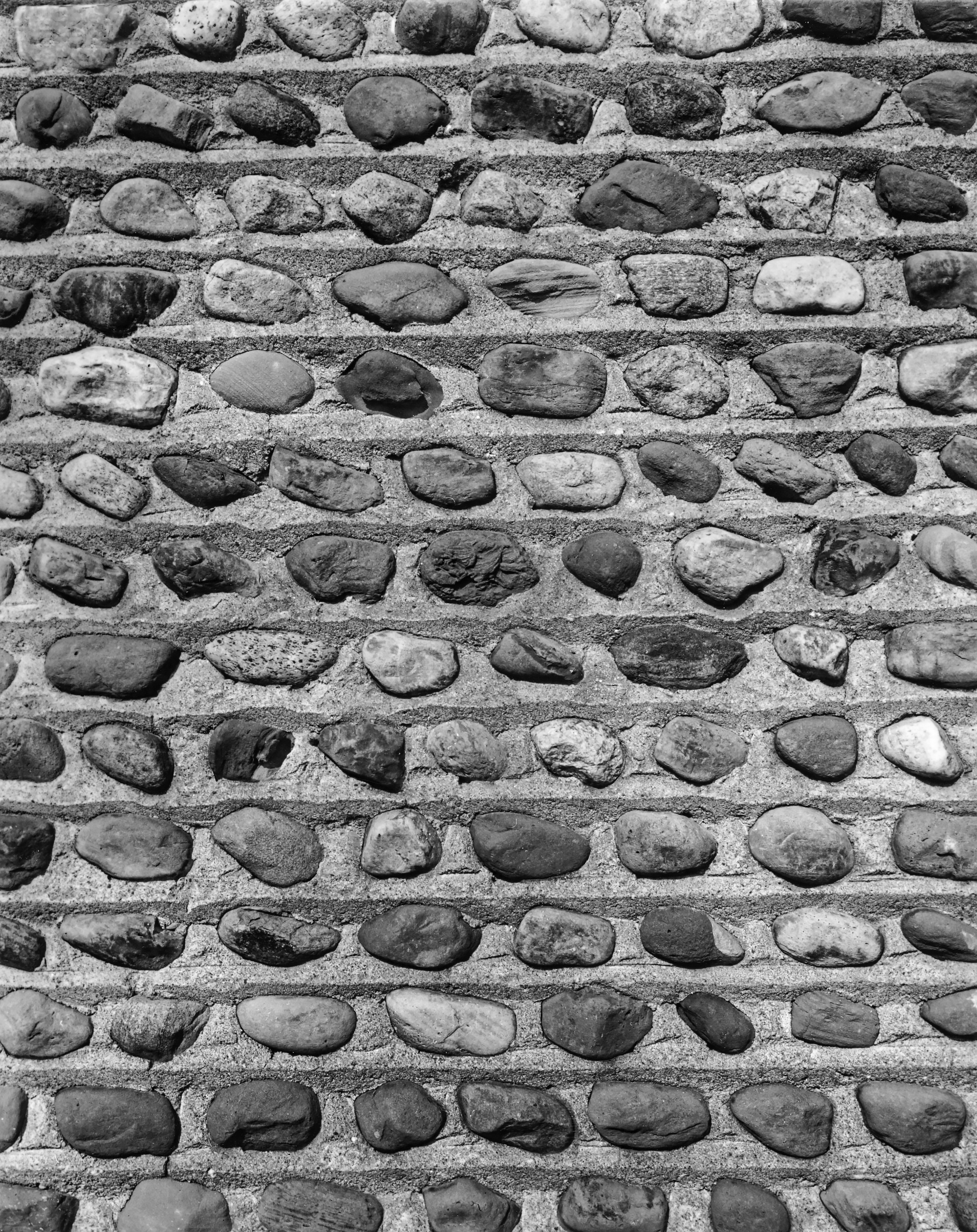 GP Misc Cobblestone Wall 8-1 P.jpg ¹ There is more variability in the selection of field cobblestone due to the irregular stone shape making size selection, stone placement, and application of mortar inconsistent. | 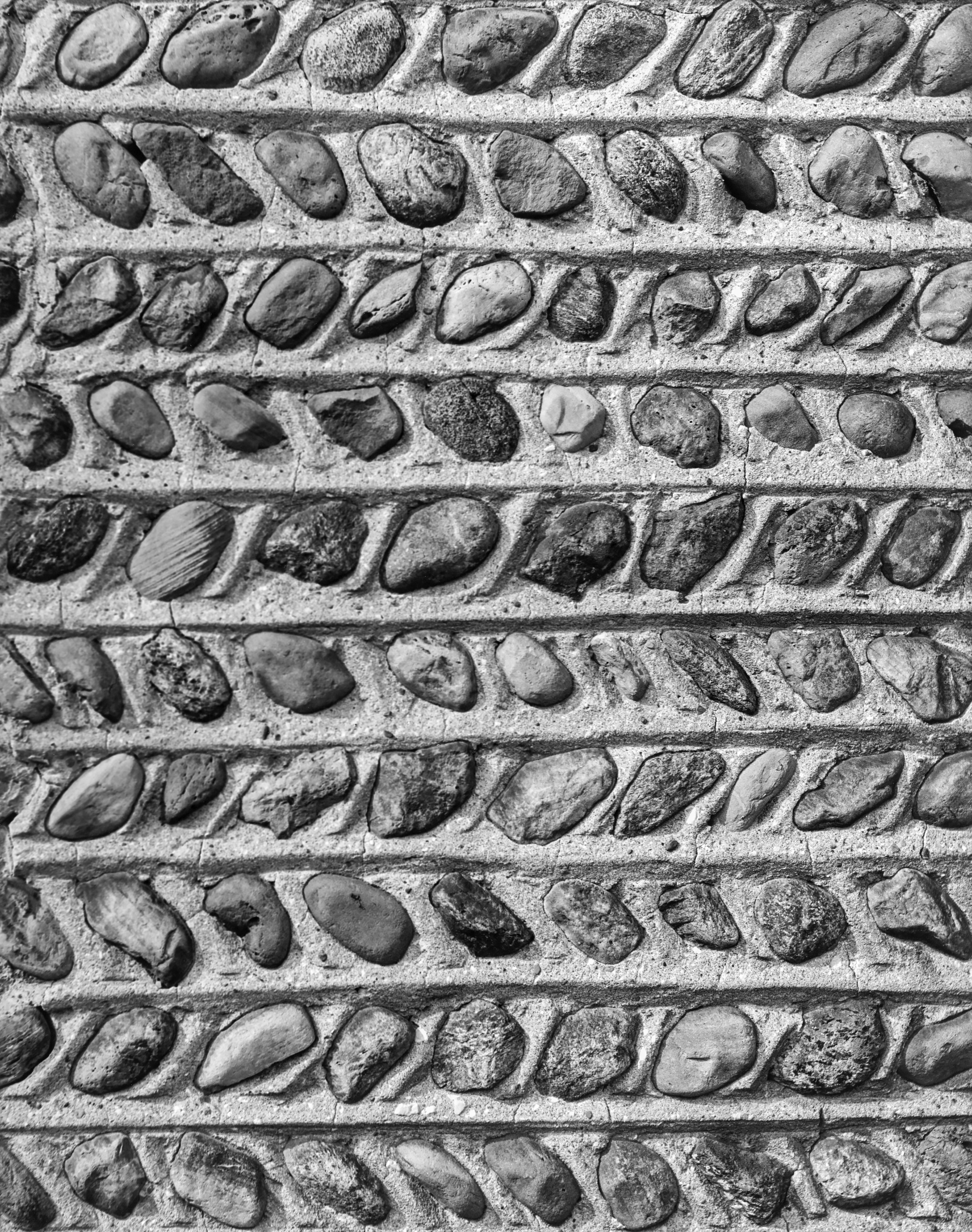 GP Misc Cobblestone Veneer 5-1 P.jpg ¹ Herringbone fieldstone pattern. | 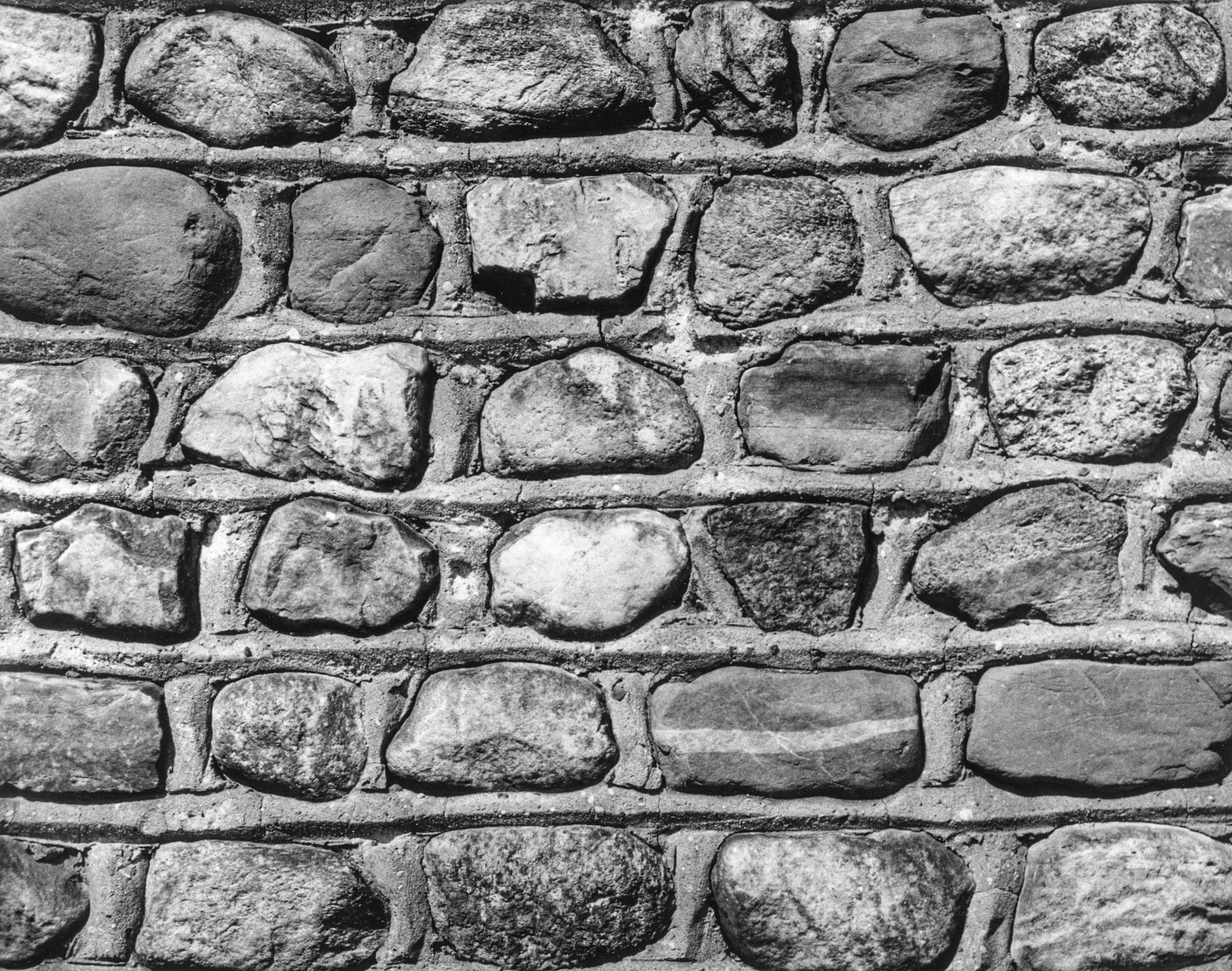 GP Misc Cobblestone Veneer 3-1 P.jpg ¹ Larger flatter fieldstone laid horizontally. Horizontal and vertical "V" mortar pattern. |
| A structure with walls constructed of all stones of any type laid in an unstructured or random arrangement, regardless of quality of appearance, OR stones shaped by cutting, usually in an organized and consistent manner, is not an authentic cobblestone structure. However, an authentic cobblestone structure may have limited small areas of less organized stone arrangement, or have a significant areas of both authentic cobblestone construction, and non-authentic stone construction. There is a wide range of variety with cobblestone structures; therefore, there is a gray area where opinion varies as to how to classify a structure as cobblestone or stone. To view a wide selection of non-cobblestone, or often simply referred to as "stone" structures, see the Faux Cobblestone Structures page. The premiss is that the Cobblestone Info Base is an educational resource for the general public as well as historians, enthusiasts and architects; thus, it is necessary to provide content to explain and demonstrate what construction features are considered when appraising whether or not a structure is an authentic cobblestone structure. It is possible for a structure to be a hybrid of both. | |||
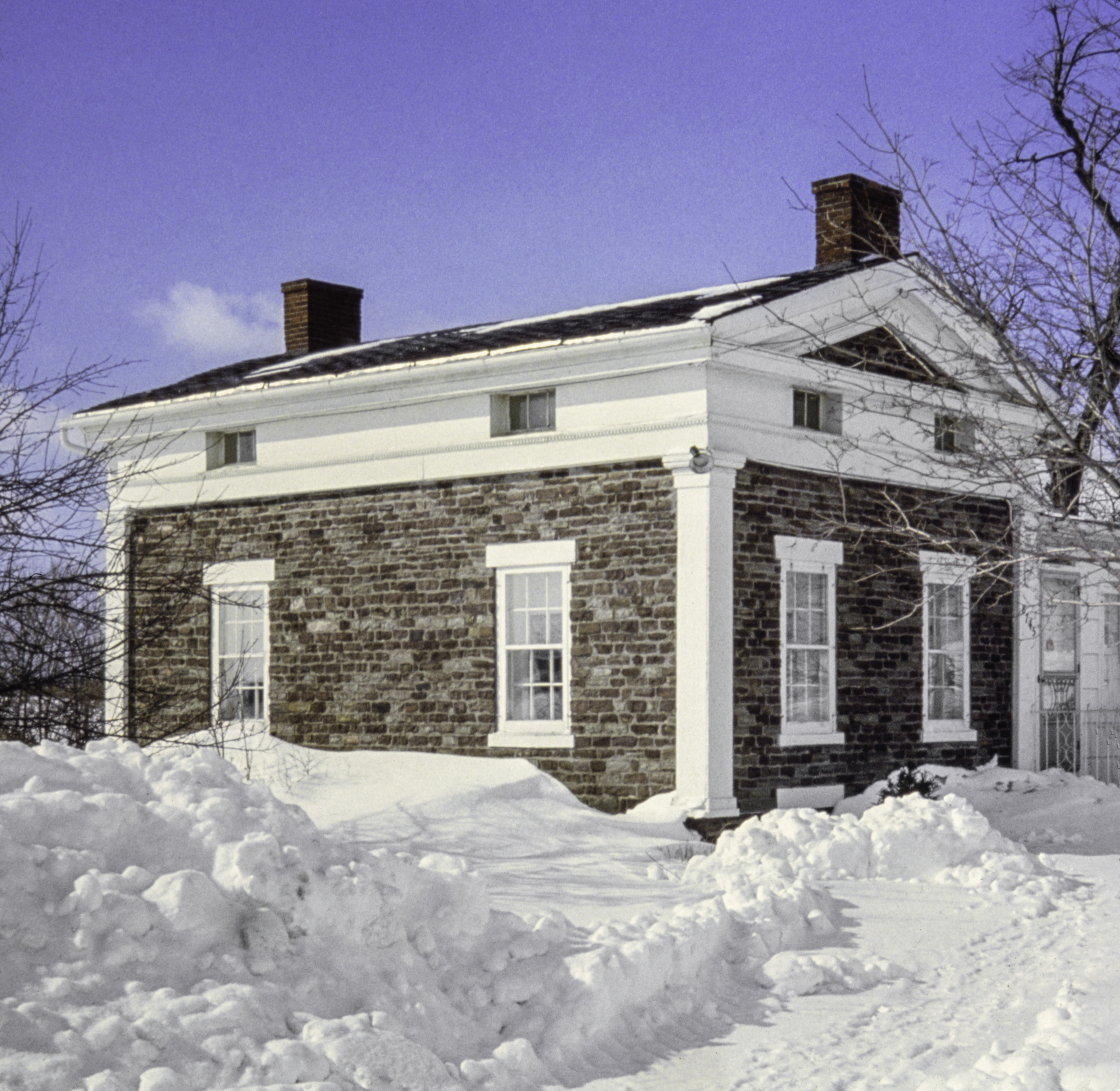 8745 Ridge Road 1.jpg ² Cut or split stone with flat face. | 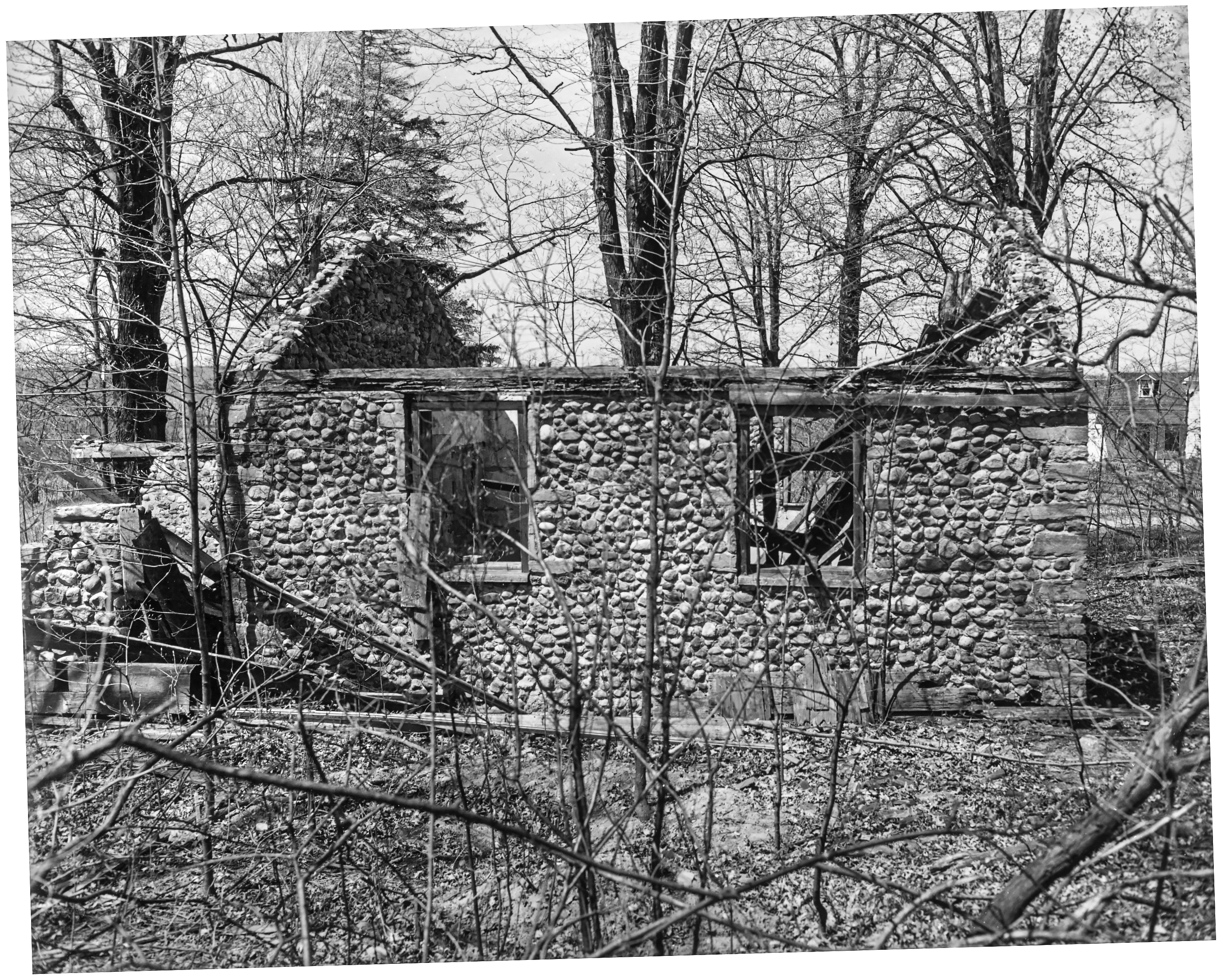 GP Misc Cobblestone Wall 9-1 P.jpg ¹ Random pattern. | ||
History of Cobblestone Construction | |||
| In Great Britain and Europe there are very early examples of cobblestone construction. | |||
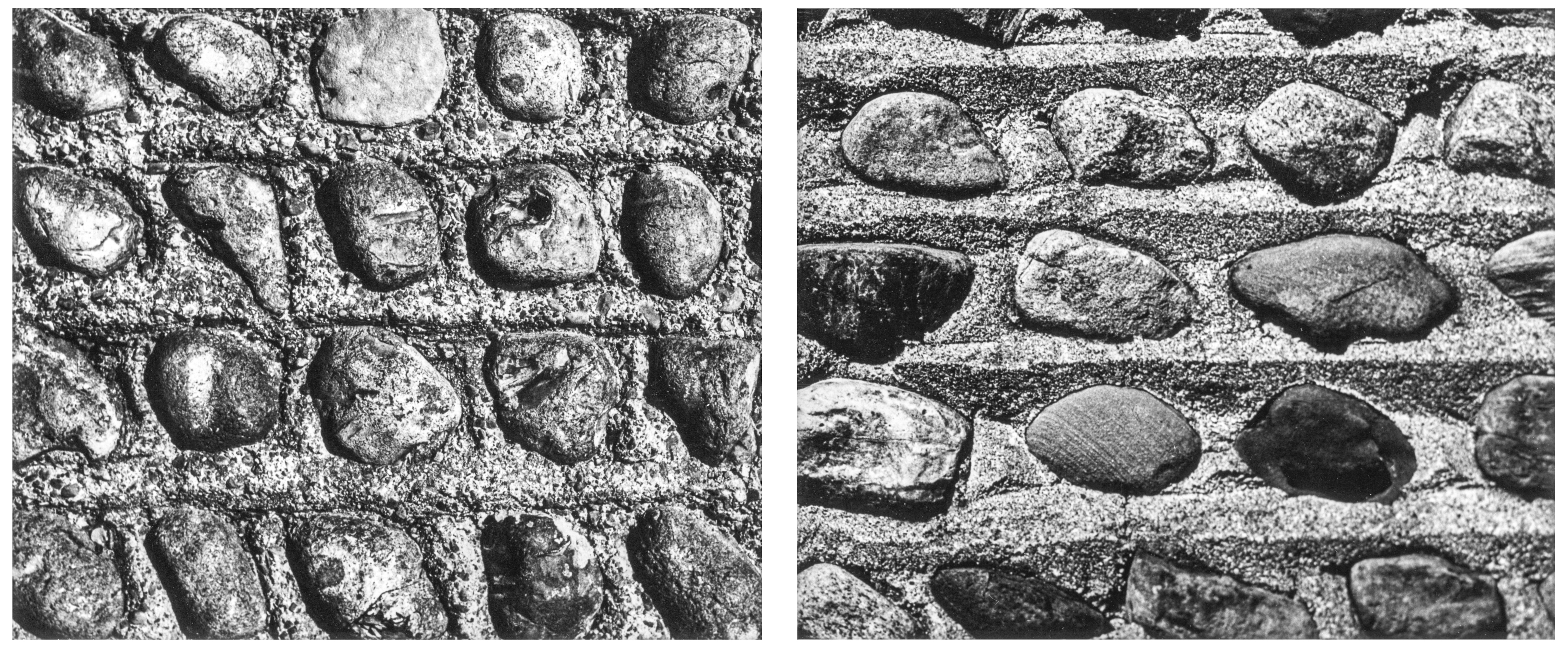 GP Misc Cobblestone Wall 10-1 P.jpg Cropped left image. GP Misc Cobblestone Wall 10-2 P.jpg Full left image. ¹ | |||
| Left: A photograph of flint cobblestone technique taken at Styning, Sussex, England, by an English photographer about 1953. Right: Compare to a photograph with the same treatment in an early United States cobblestone wall. Flints are generally found in combination with other materials with chalk in Berkshire, Buckinghamshire, and Willshire, with brick in the clay districts of Hampshire, Sussex, and Kent, and with both chalk and brick in parts of East Anglia. Here "galleting" or "garneting" is practiced, a local method of pressing flint chips into the wet mortar that produces a pleasant piebald pattern. The English Village, by Victor Bonham-Carter, Pelican 1952.
| 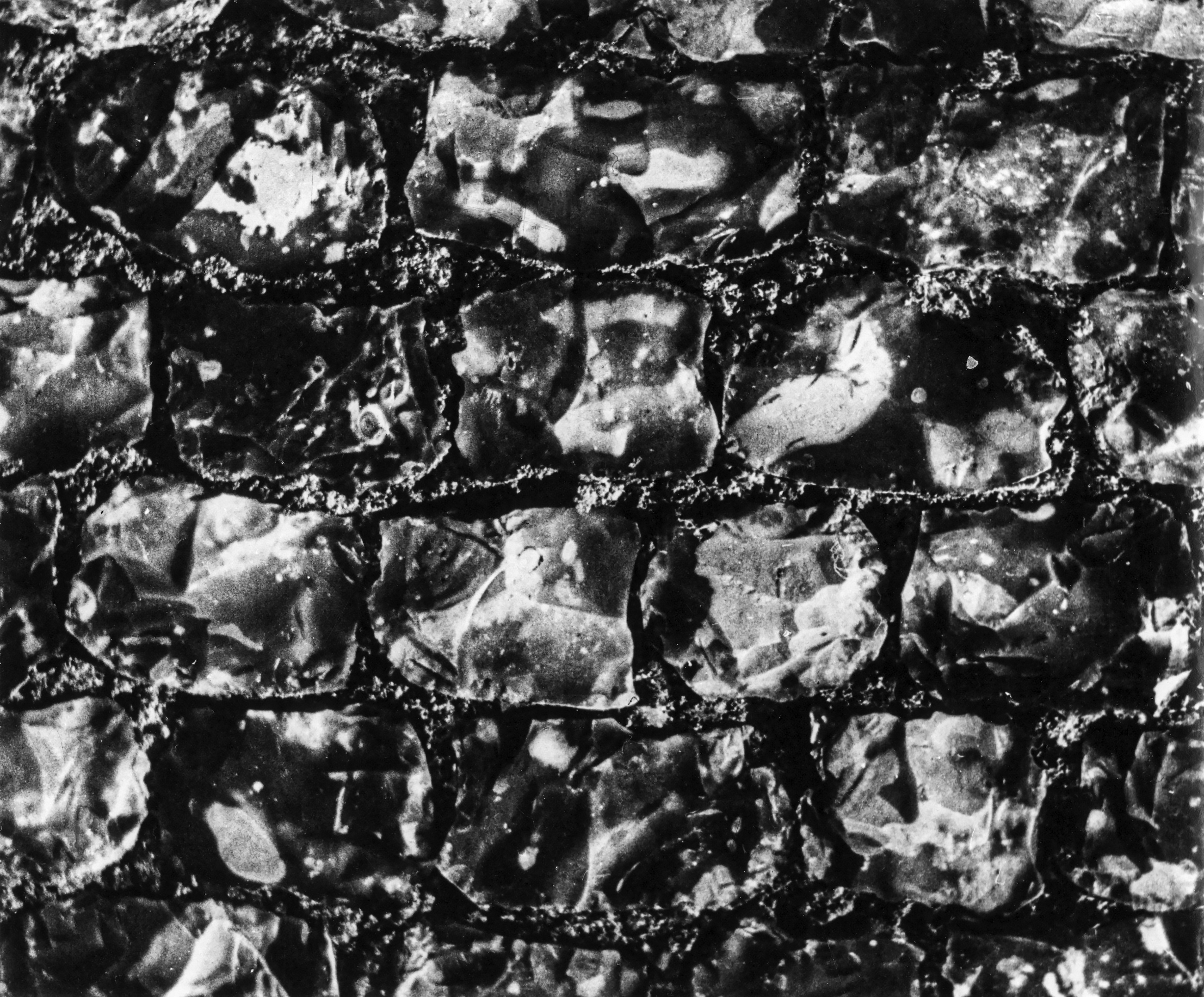 GP Misc Cobblestone Wall 12-1 P.jpg ¹ | 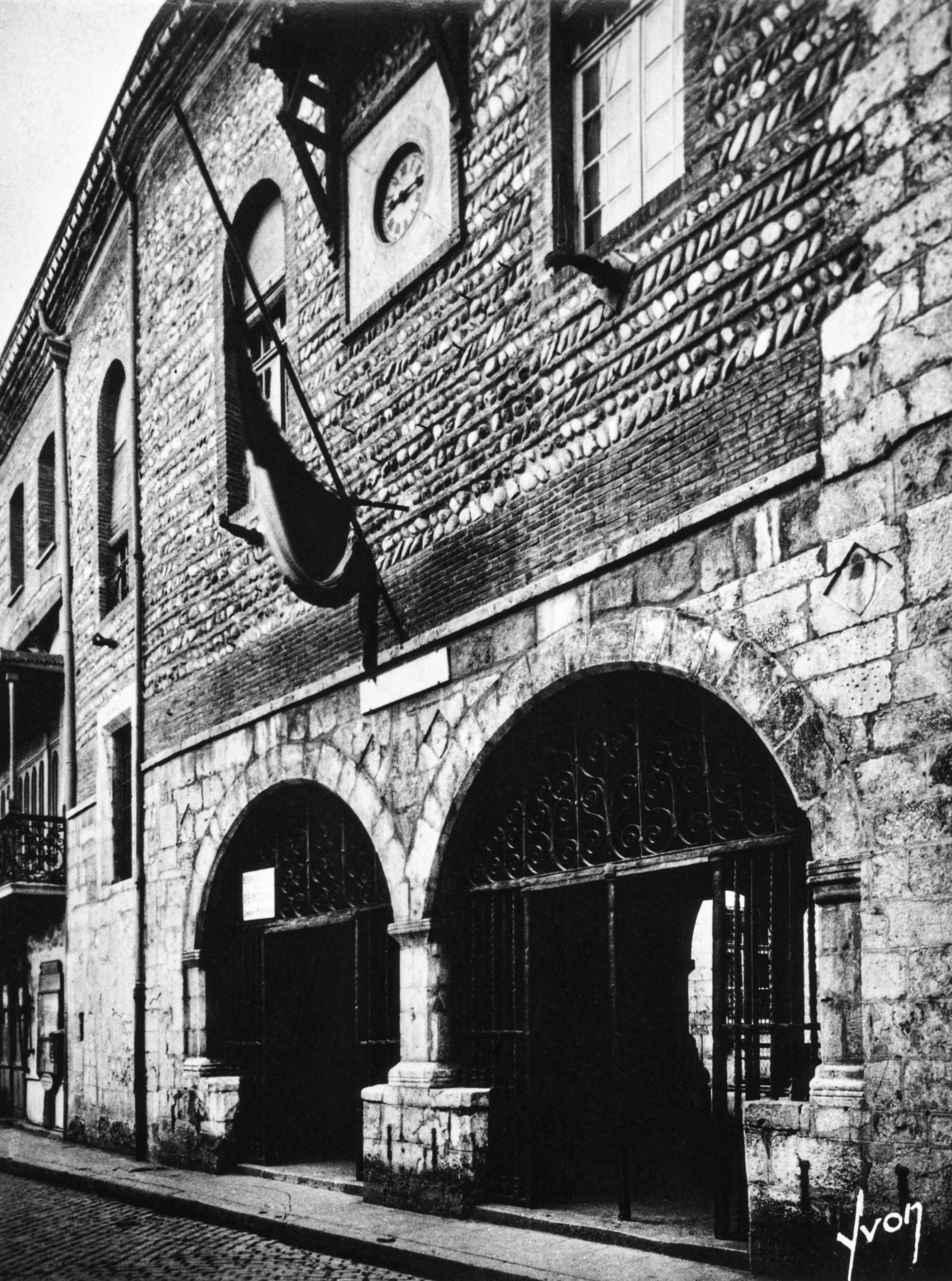 GP Misc Cobblestone Wall 13-1 P.jpg ² | 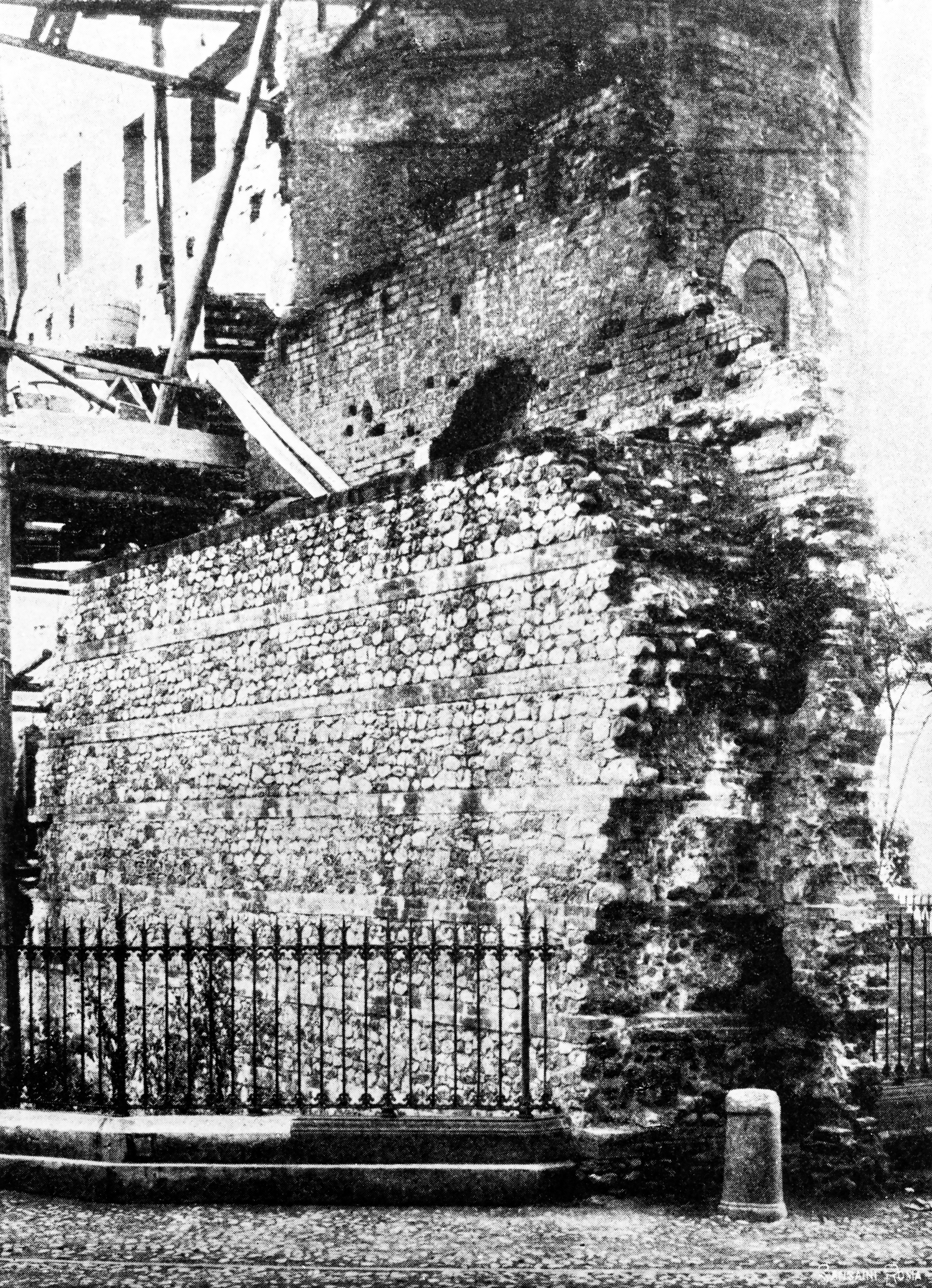 GP Misc Cobblestone Wall 14-1 P.jpg ² |
| Left to right: Flint cobblestone technique taken at Styning; City Hall, Perpignan, Hautes Pyrenees, France; and Turin, Porta Palatina, Italy, inner face of wall. |
² Image courtesy Cobblestone Museum.
³ English photographer circa 1953
4 "The Building Mechanics' Ready Reference", Stone and Brickmasons' Edition, H. G. Richey, John Wiley and Sons N. Y., 1907, page 7
